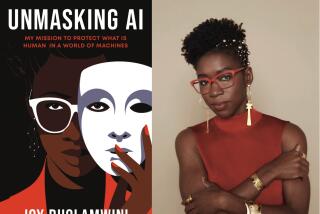To Reveal One’s True Feelings, the Eyes Have It
- Share via
PITTSBURGH — Want to know if a grin or a pout comes from the heart? It’s all in the eyes.
The problem with faking an emotion, according to University of Pittsburgh psychologist Jeffrey Cohn, is that most people have more control over the lower half of their face than the upper. So smiles and frowns may be screaming “happy” or “sad,” but the eyes and forehead are quiet.
“In felt expressions of joy, people both smile and they tighten the muscles around the eyes. When a smile lacks that, it appears false,” Cohn said.
A 20-year-old code that describes 44 types of facial expressions is widely used by psychologists such as Cohn to help them learn more about human emotions. Now some are trying to teach computers the code to speed up their research.
If they succeed, the technology could be used beyond the laboratory. It could help humanize computers and robots, teach parents about their babies, reveal patients’ moods to doctors and even root out liars.
Cohn and at least two other groups of researchers--at the Salk Institute and at Massachusetts Institute of Technology--are working on programs using the code written by psychologist Paul Ekman in the 1970s.
“You can think of it as a musical notation in terms of the face. It provides you with a mechanism and language,” said Ekman of UC San Francisco. Ekman has helped train actors in facial expression and has written books, including “What the Face Reveals” and “Telling Lies.”
To introduce Ekman’s code to the computer, Cohn uses a series of video clips of his assistant, graduate student Adena Zlochower, wrinkling her nose in disgust or widening her mouth and eyes in surprise, among other expressions.
The computer looks for changes in lines and shadows in tiny blocks of the face. So far, it can identify about half of Ekman’s 44 types of expressions.
But the program is a long way from commercial use. The researchers haven’t decided how to account for side-to-side movement of the head and other variables such as light and color.
If researchers can make it work, a computer could read faces much faster than humans. Trained psychologists need up to 10 hours to analyze one minute of a facial expression, but a computer could “read” that expression at normal speed--a minute.
Cohn already uses the manual facial analysis code to study how babies interact with their mothers, and Zlochower is studying whether the speed of a smile is related to its authenticity. A computer could accelerate those projects considerably.
Years from now, computers--using input from video cameras--could be used in all sorts of situations to reveal a person’s emotions.
A computer, for example, could tell police when a suspect’s expression fails to match his words. A lie detector based on reading the face could never be relied on to prove guilt or innocence, researchers said, but could enhance today’s polygraph tests.
Ekman said he has found 35 indicators--most involving facial expressions--that tell him a person may be fibbing.
“Lying is one of the most complex things that people do in terms of the face,” Ekman said. A computer could help put the pieces together quickly, identifying eyebrow shapes that fail to coincide with downturned lips, for instance.
An automated facial analysis program also could help humanize computers and robots--as long as they had built-in video cameras, said Takeo Kanade, director of the Robotics Institute at Carnegie Mellon University. He is helping Cohn design his program.
A computer could respond to its user’s mood or put a face on e-mail by translating the expression of the sender. By mounting video cameras on televisions, TV and advertising executives could gauge minute-by-minute reactions to their shows or products, Kanade said.
And there are other possibilities.
Quadriplegics could use a version of the program to control a camera-mounted computer with facial movements, Cohn suggested.
Parents could judge the effectiveness of day care better if the computer could read the subtleties of their babies’ reactions from a video monitor, he said.





